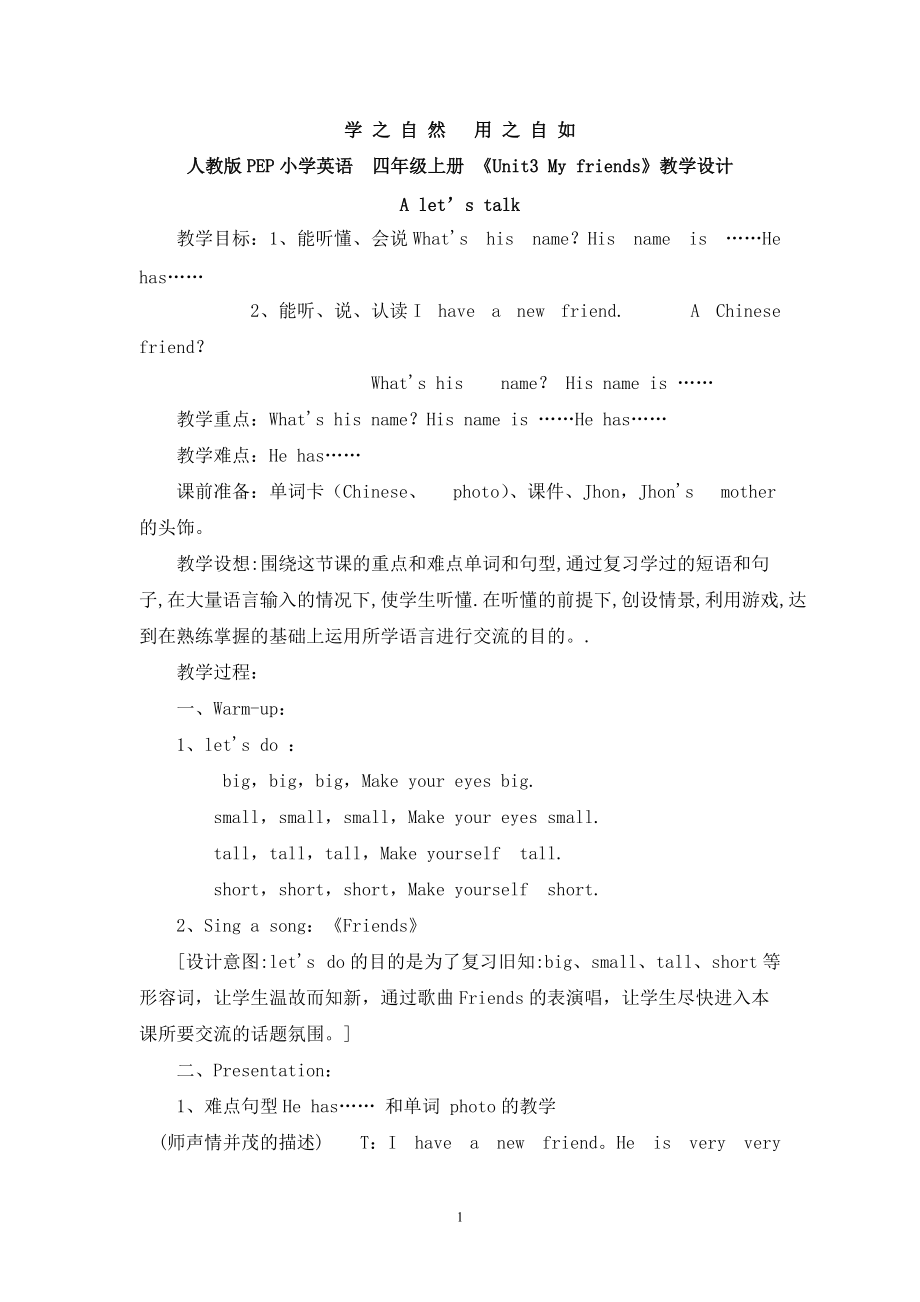《人教版PEP小學(xué)英語四年級(jí)上冊 《Unit3 My friends》教學(xué)設(shè)計(jì)》由會(huì)員分享����,可在線閱讀,更多相關(guān)《人教版PEP小學(xué)英語四年級(jí)上冊 《Unit3 My friends》教學(xué)設(shè)計(jì)(5頁珍藏版)》請(qǐng)?jiān)谘b配圖網(wǎng)上搜索�。
1、
學(xué) 之 自 然 用 之 自 如
人教版PEP小學(xué)英語 四年級(jí)上冊 《Unit3 My friends》教學(xué)設(shè)計(jì)
A let’s talk
教學(xué)目標(biāo):1��、能聽懂����、會(huì)說Whats his name����?His name is ……He has……
2����、能聽���、說�、認(rèn)讀I have a new friend. A Chinese friend��?
Whats his name�? His name is ……
教學(xué)重點(diǎn):Whats his name?His name is ……He has…
2�����、…
教學(xué)難點(diǎn):He has……
課前準(zhǔn)備:單詞卡(Chinese����、 photo)、課件�����、Jhon,Jhons mother的頭飾�����。
教學(xué)設(shè)想:圍繞這節(jié)課的重點(diǎn)和難點(diǎn)單詞和句型,通過復(fù)習(xí)學(xué)過的短語和句子,在大量語言輸入的情況下,使學(xué)生聽懂.在聽懂的前提下,創(chuàng)設(shè)情景,利用游戲,達(dá)到在熟練掌握的基礎(chǔ)上運(yùn)用所學(xué)語言進(jìn)行交流的目的���。.
教學(xué)過程:
一�����、Warm-up:
1�����、lets do :
big����,big��,big���,Make your eyes big.
small��,small����,small,Make your eyes s
3�����、mall.
tall�����,tall�,tall��,Make yourself tall.
short����,short,short�����,Make yourself short.
2�����、Sing a song:《Friends》
[設(shè)計(jì)意圖:lets do的目的是為了復(fù)習(xí)舊知:big、small�、tall、short等形容詞�����,讓學(xué)生溫故而知新�,通過歌曲Friends的表演唱,讓學(xué)生盡快進(jìn)入本課所要交流的話題氛圍�����。]
二����、Presentation:
1、難點(diǎn)句型He has…… 和單詞 photo的教學(xué)
(師聲情并茂的描述) T:I have a
4���、 new friend�。He is very very tall�����。He has a big mouth,small eyes�����。He has big ears�。He has short hair。Do you know�,who’s he?
T:Please look���,this is his photo�����。(師出示照片讓學(xué)生明白photo的意思,再出示詞卡���,教讀�����,找生讀�����,貼到黑板上)
2�、 What’s his name? His name is 的教學(xué)��。
課件出示姚明的照片����,Let’s look。師與學(xué)生一起再把照片描述一下引出His name is 句型并板書
5���、���,然后出示幾張卡通人物的照片進(jìn)行問答練習(xí),通過多次問答形式引出句子What’s his name�����?并板書�。師領(lǐng)讀板書的主句型,針對(duì)班里的其他男生��,進(jìn)行師生����、生生問答練習(xí)���。
(1)Play a game:全班分為兩組�����,每組選一生上臺(tái)�����,臺(tái)下學(xué)生對(duì)課件中所選定的人物照片進(jìn)行描述�����,并問What’s his name�?臺(tái)上的學(xué)生誰先猜出來即為勝利者����。
游戲分為2組 : 一組(大頭兒子、小新����、一休)
二組(劉歡、劉翔�����、豬八戒)
(2)出示let’s chant:做鞏固練習(xí)
I have a new (good,Chinese )friend.
6���、
I have a new (good,Chinese )friend.
He has big eyes. He is tall.
Hello���,what’s his name?
Hello�����,what’s his name�����?
His name is 姚明.His name is 姚明.����。(用"兩只老虎"的曲調(diào)進(jìn)行)
[設(shè)計(jì)意圖:針對(duì)重、難點(diǎn)句型我采用了趣引����、巧練、游戲����、chant鞏固等形式讓學(xué)生對(duì)知識(shí)從新到熟去掌握并運(yùn)用.]
三�、practice:
1����、教授Chinese 。
T:Cl
7�����、ass�,Im form China。Where are you form���?
Ss:Im form China ���,too。
T:Nice to meet you ���。
Ss:Nice to meet you,too。
T:We are Chinese��。(師出示詞卡���,教讀���,讓生明白意思�����,找生讀�,然后把詞卡貼到黑板上)指著班里的學(xué)生說Chinese girl��,Chinese boy���,讓生明白并會(huì)運(yùn)用��。
2�、師出示Jhon����,Jhon’s mother 的頭飾,
T:Boys and girls: Whats his name��? His name is
8����、 ����。
Now���,Jhon is talking about his new friend to his mother.
?。?)Listen and answer:師大熒幕出示:Whats his friends name���?(讓學(xué)生帶著問題聽,聽后回答)
?����。?)Open the book�,p29���。 Listen and repeat. (讓生跟著錄音機(jī)讀對(duì)話,注意模仿錄音中的語音和語調(diào))
?。?)Read the dialogue by yourself.
(4)Act this dialogue.(師準(zhǔn)備好Jhon���,Jhon’s mother 的頭飾���,師生\生生進(jìn)行
9、對(duì)話表演)
(5)Listen and number.
四��、Production:
1��、Group Work:
在小組內(nèi)把你所帶照片上的朋友介紹給你的同學(xué).
Like this:(供你參考)
A: Hello, B名字. I have a new friend.
B: A boy?
A: Yes. He has hair and eyes.
B: Whats his name���?
A: His name is 名字. Look, this is his photo.H
10�����、e is strong.
?。?)師出示例子��,先與一生做示范展示����。
(2)小組活動(dòng)���。
?����。?)上臺(tái)展示����。
[設(shè)計(jì)意圖:通過介紹自己身邊的朋友這一任務(wù),把所學(xué)語言真正運(yùn)用到實(shí)際生活中,達(dá)到了學(xué)以致用的目的.]
2、Let’check 達(dá)標(biāo)測試
Choose and fill in the blanks. (選擇反義詞填空)
tall long new strong
1�����、John has short hair. Sarah has hair.
2����、 John is short. His father is
11、 .
3�、Wu Yifan is thin. Zhang Peng is .
4、Chen Jie is my friend. Sarah is my old friend.
Read and choose .
( )1�����、I have a friend.
A��;Chinese B�����;chinese
( )2�����、She big eyes. A:have B:has
( )3、Amy 向媽媽說自己有一位新朋友���,該如何說����?
12���、 Amy: .
A:Mom,I have a new classroom.
B:Mom�, I have a new friend.
( )4、如果你的向朋友詢問一個(gè)男孩的名字���,該怎么問���?
A:Whats her name? B: Whats his name�?
3、課堂總結(jié)評(píng)價(jià)��。
13�����、 . 五、Progress:
1����、Introduce your new friends to your parents.
2、Make a name card for yourself or your friends.
[課堂的終點(diǎn)在哪里?我想應(yīng)該還在課外,因此,我以本課為延伸,鼓勵(lì)學(xué)生動(dòng)手制作名片,并把自己的朋友介紹給父母,增強(qiáng)與朋友和家長的情感.]
教學(xué)反思:
一���、勤反復(fù)重積累�,訓(xùn)練學(xué)生活用語言
英語是一門語言實(shí)踐性很強(qiáng)的課程�����。小學(xué)生識(shí)記快�、忘的也快。因此����,在英語教學(xué)中必須遵循“勤反復(fù)重積累”的原則。本課句型教學(xué)時(shí)���,我設(shè)計(jì)了以舊帶新的環(huán)節(jié)����,巧妙結(jié)合以前積累的詞匯和句型�,自然引出新的內(nèi)容�����。既復(fù)習(xí)舊知��,又教學(xué)新知����,從而培養(yǎng)學(xué)生實(shí)際運(yùn)用語言的能力����,兩全其美����。
二、聯(lián)系生活實(shí)際��,引導(dǎo)學(xué)生語言表達(dá)
教育源于生活�����,更要用于生活�����。為了挖掘?qū)W生的潛能,啟發(fā)學(xué)生對(duì)所學(xué)語言進(jìn)行合理的��、創(chuàng)造性的運(yùn)用��,正鎮(zhèn)體現(xiàn)語言的交際功能��,在教學(xué)本課時(shí)緊密聯(lián)系了學(xué)生們的日常生活���,在不知不覺中使學(xué)生學(xué)之自然��,用之自如����。
5
 人教版PEP小學(xué)英語四年級(jí)上冊 《Unit3 My friends》教學(xué)設(shè)計(jì)
人教版PEP小學(xué)英語四年級(jí)上冊 《Unit3 My friends》教學(xué)設(shè)計(jì)

